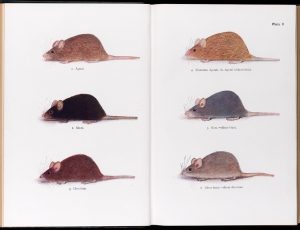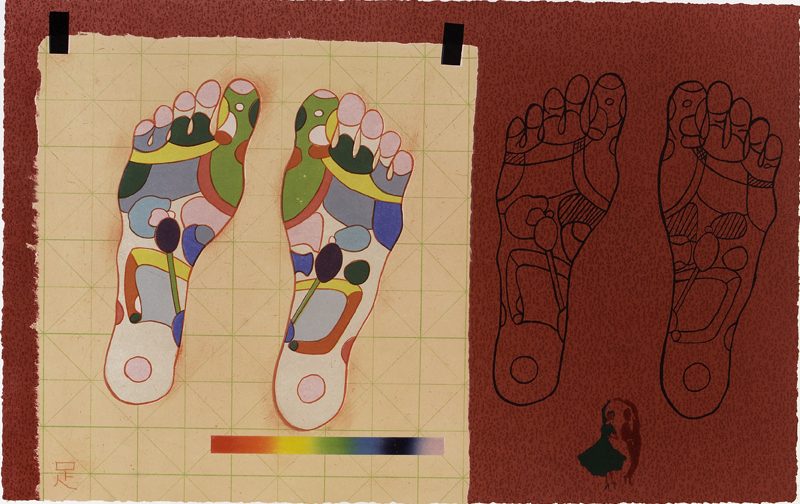Towards Dolly: animal genetics archives at the University of Edinburgh
Posted onClare Button, Project Archivist, University of Edinburgh
Today, Edinburgh is world-renowned as a centre for animal genetics and genomics. This history stretches back over a century, and has left a rich documentary record. Over the past four years, Edinburgh University Library Special Collections has received two large grants as well as a scoping and digitisation grant, all under the Wellcome Trust’s Research Resources scheme, to preserve, catalogue and make available this important heritage.
I started as Project Archivist in 2012 with the project ‘Towards Dolly: Edinburgh, Roslin and the Birth of Modern Genetics.’ Since then, the work of this and related projects has encompassed a variety of activities: book and archive cataloguing, conservation, digitisation, public engagement, oral histories, an exhibition and academic research.

The earliest archival collection relates to James Cossar Ewart, professor of natural history at the University from 1882 to 1927, who was instrumental in establishing genetics as a subject at the University. He is most famous for carrying out cross-breeding experiments on zebras, of which there are some fascinating photographs. The most recent collection is the records of the Roslin Institute, who hit world news with the birth of Dolly the sheep in 1996. And it’s not all just about the science: the collections also comprise artwork, a record of scientists singing comedy genetics songs, photographs of social events, a vintage microscope and even wooden signs from buildings! These collections tell the story of how genetics has diversified over the last century, from large-scale and long-running animal breeding experiments and perilous work with mustard gas, to modern-day cloning, stem cells and biotechnology. Since the projects began we have continued to receive donations from scientists and their families, which has expanded our collections from the original 9 to 23 (and counting).

In addition to the archives, we also hold an array of published scientific papers and some outstanding rare books originally from Roslin’s library, the earliest of which dates from 1573! These papers and books were catalogued by the project’s Rare Book Cataloguer, Kristy Davis, as were a collection of 3,500 glass photographic slides dating from the late 19th to early 20th century. This collection depicts not only different breeds of livestock but also people and scenes from around the world (our favourite is a picture of a man riding a llama). This fragile collection received conservation treatment, as did a number of rare books and archival items, and in 2014 the slides were also digitised to further facilitate access. All the slides are now available to view online at http://images.is.ed.ac.uk/luna/servlet/UoEgal~6~6.

At first I was daunted that my lack of genetics knowledge would make cataloguing difficult. However, we were lucky to have support from two academic advisers, Steve Sturdy (Professor of the Sociology of Medical Knowledge, University of Edinburgh) and Grahame Bulfield (former director of Roslin and Emeritus Professor of Genetics, University of Edinburgh). Steve and Grahame helped decipher laboratory notebooks, identify people and places and introduced us to useful contacts. This said, being immersed in the collections for so long has improved my scientific vocabulary, and I’m pleased to say I now know my DNA from my Drosophila…
We’ve worked hard to engage the research community with these rich collections by presenting at conferences, networking at University events and maintaining a blog (http://libraryblogs.is.ed.ac.uk/towardsdolly/). However, it has also been valuable to engage with the public about the collections and the stories they tell. At events like the Edinburgh International Science Festival, Doors Open Day and talks at local history societies, people often express a real sense of local pride in Dolly and surprise at the diversity of genetics research in Edinburgh’s history. Probably our most successful piece of engagement was the exhibition ‘Towards Dolly: a century of animal genetics in Edinburgh’, which ran in the Main Library from July to October 2015. This featured an array of material from our collections as well as items on loan from scientific institutions (including DNA models, stem cell artwork and the microscope used to clone Dolly) and, of course, Dolly the sheep herself from National Museums Scotland. Dolly is a hugely popular exhibit, and the exhibition received our highest ever visitor figures as well as a proliferation of ‘Dolly selfies’! You can see some of the exhibits here: https://exhibitions.ed.ac.uk/search/*:*/Exhibition:%22towards+dolly%7C%7C%7CTowards+Dolly%22

‘
As comprehensive as the collections appear to be, there are inevitably gaps in the records. With the help of Grahame Bulfield, we carried out a series of oral history recordings with ten contemporary scientists involved in genetics and genomics, one of whom had begun work as a scientist in the 1940s. These recordings, which we plan to make available online in the future, are full of personal anecdotes, reminiscences and valuable information which are not always captured in paper records.

After working so closely with this material for a number of years, it was hard to leave it behind once the projects came to an end. I was therefore delighted to receive a Research Bursary from the Wellcome Trust, which is currently enabling me to carry out academic research on the collections I have catalogued, as well as to visit other genetics collections which have received Wellcome Trust funding. From this research I hope to produce a journal article about the early history of animal genetics in Edinburgh, as well as continuing to engage with our academic and public audiences about these diverse collections. Dolly lives on!
Find out more about the projects here:
http://collections.ed.ac.uk/towardsdolly
With thanks to the Wellcome Trust:




